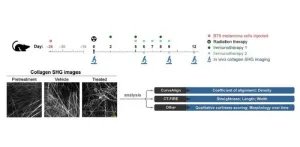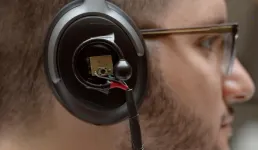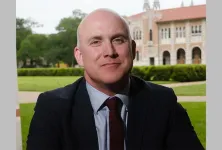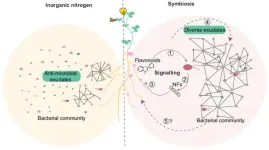(Press-News.org) Images
Closing in on the theoretical maximum efficiency, devices for turning heat into electricity are edging closer to being practical for use on the grid, according to University of Michigan research.
Heat batteries could store intermittent renewable energy during peak production hours, relying on a thermal version of solar cells to convert it into electricity later.
"As we include higher fractions of renewables on the grid to reach decarbonization goals, we need lower costs and longer durations of energy storage as the energy generated by solar and wind does not match when the energy is used," Andrej Lenert, U-M associate professor of chemical engineering and corresponding author of the study recently published in Joule.
Thermophotovoltaic cells work similarly to photovoltaic cells, commonly known as solar cells. Both convert electromagnetic radiation into electricity, but thermophotovoltaics use the lower energy infrared photons rather than the higher energy photons of visible light.
The team reports that their new device has a power conversion efficiency of 44% at 1435°C, within the target range for existing high-temperature energy storage (1200°C-1600°C). It surpasses the 37% achieved by previous designs within this range of temperatures.
"It's a form of battery, but one that's very passive. You don't have to mine lithium as you do with electrochemical cells, which means you don't have to compete with the electric vehicle market. Unlike pumped water for hydroelectric energy storage, you can put it anywhere and don't need a water source nearby," said Stephen Forrest, the Peter A. Franken Distinguished University Professor of Electrical Engineering at U-M and contributing author of the study.
In a heat battery, thermophotovoltaics would surround a block of heated material at a temperature of at least 1000°C. It might reach that temperature by passing electricity from a wind or solar farm through a resistor or by absorbing excess heat from solar thermal energy or steel, glass or concrete production.
"Essentially, using electricity to heat something up is a very simple and inexpensive method to store energy relative to lithium ion batteries. It gives you access to many different materials to use as a storage medium for thermal batteries," Lenert said.
The heated storage material radiates thermal photons with a range of energies. At 1435°C, about 20-30% of those have enough energy to generate electricity in the team's thermophotovoltaic cells. The key to this study was optimizing the semiconductor material, which captures the photons, to broaden its preferred photon energies while aligning with the dominant energies produced by the heat source.
But the heat source also produces photons above and below the energies that the semiconductor can convert to electricity. Without careful engineering, those would be lost.
To solve this problem, the researchers built a thin layer of air into the thermophotovoltaic cell just beyond the semiconductor and added a gold reflector beyond the air gap—a structure they call an air bridge. This cavity helped trap photons with the right energies so that they entered the semiconductor and sent the rest back into the heat storage material, where the energy had another chance to be re-emitted as a photon the semiconductor could capture.
"Unlike solar cells, thermophotovoltaic cells can recuperate or recycle photons that are not useful," said Bosun Roy-Layinde, U-M doctoral student of chemical engineering and first author of the study.
A recent study found stacking two air bridges improves the design, increasing both the range of photons converted to electricity and the useful temperature range for heat batteries.
"We're not yet at the efficiency limit of this technology. I am confident that we will get higher than 44% and be pushing 50% in the not-too-distant future," said Forrest, who also is the Paul G. Goebel Professor of Engineering and professor of electrical engineering and computer science, materials science and engineering, and physics.
The team has applied for patent protection with the assistance of U-M Innovation Partnerships and is seeking partners to bring the technology to market.
This research is based upon work supported by the National Science Foundation (grant numbers 2018572 and 2144662) and the Army Research Office (grant number W911-NF-17-0312).
Study: High efficiency air-bridge thermophotovoltaic cells (DOI:10.1016/j.joule.2024.05.002)
END
Renewable grid: Recovering electricity from heat storage hits 44% efficiency
Thermophotovoltaics developed at U-M can recover significantly more energy stored in heat batteries
2024-05-23
ELSE PRESS RELEASES FROM THIS DATE:
Galaxies actively forming in early universe caught feeding on cold gas
2024-05-23
Researchers analyzing data from NASA’s James Webb Space Telescope have pinpointed three galaxies that may be actively forming when the universe was only 400 to 600 million years old. Webb’s data shows these galaxies are surrounded by gas that the researchers suspect to be almost purely hydrogen and helium, the earliest elements to exist in the cosmos. Webb’s instruments are so sensitive that they were able to detect an unusual amount of dense gas surrounding these galaxies. This gas will likely end up fueling the formation of new stars in the galaxies.
“These ...
Developing novel methods to detect antibiotics in vegetables and earthworms
2024-05-23
“The massive use of antibiotics and antimicrobials in people and animals has led to these substances appearing in unexpected environmental samples,” said Irantzu Vergara, researcher in the UPV/EHU’s IBeA group. Drugs that do not end up fully metabolised in the body reach the environment through various routes (such as manure, sewage sludge used as fertilisers, etc.), are leached into the soil and may end up transferring to crops or earthworms, which are at the base of the food chain. “Although ...
New biomarkers of response in melanoma immunotherapy
2024-05-23
Collagen, a major component of the extracellular matrix, plays a crucial role in tumor development. During the development of tumors (“tumorigenesis”), collagen fibers become linearized and densely deposited, hindering immune cell infiltration and promoting tumor metastasis. However, quantifying these collagen changes during melanoma progression has been challenging.
In-vivo imaging of collagen
As reported in Biophotonics Discovery, researchers from the Morgridge Institute for Research and University of Wisconsin – Madison recently addressed this challenge by using quantitative imaging to visualize collagen ...
AI headphones let wearer listen to a single person in a crowd, by looking at them just once
2024-05-23
Noise-canceling headphones have gotten very good at creating an auditory blank slate. But allowing certain sounds from a wearer’s environment through the erasure still challenges researchers. The latest edition of Apple’s AirPods Pro, for instance, automatically adjusts sound levels for wearers — sensing when they’re in conversation, for instance — but the user has little control over whom to listen to or when this happens.
A University of Washington team has developed an artificial intelligence system that lets a ...
Electromechanical material doesn’t get ‘clamped’ down
2024-05-23
HOUSTON – (May 23, 2024) – Lighting a gas grill, getting an ultrasound, using an ultrasonic toothbrush ⎯ these actions involve the use of materials that can translate an electric voltage into a change in shape and vice versa.
Known as piezoelectricity, the ability to trade between mechanical stress and electric charge can be harnessed widely in capacitors, actuators, transducers and sensors like accelerometers and gyroscopes for next-generation electronics. However, integrating these materials into miniaturized systems has been difficult ...
Most young women treated for breast cancer can have children, study shows
2024-05-23
In a study of nearly 200 young women who have survived breast cancer, most of those who tried to conceive were able to become pregnant and give birth
This study fills in major gaps from previous studies of fertility among breast cancer survivors
BOSTON – New research by Dana-Farber Cancer Institute investigators has encouraging news for young women who have survived breast cancer and want to have children.
The study, which tracked nearly 200 young women treated for breast cancer, found that the majority of those who tried to conceive during a median of 11 years after treatment were able to become pregnant and give birth to a child.
The findings, ...
SWOG researchers will present key results at ASCO 2024
2024-05-23
Researchers from SWOG Cancer Research Network, a cancer clinical trials group funded by the National Cancer Institute (NCI), part of the National Institutes of Health (NIH), will share results of their work in 30 presentations at the 2024 American Society of Clinical Oncology (ASCO) Annual Meeting, which takes place May 31 – June 4 in Chicago.
The clinical trials reported on in this work are led by SWOG and conducted by the NIH-funded NCI National Clinical Trials Network (NCTN) and the NCI Community Oncology Research ...
MD Anderson Research Highlights: ASCO 2024 Special Edition
2024-05-23
ABSTRACTS: 2018, 2517, 3513, 5504, 6016, 7007, 9515, 12017, LBA8007, LBA9516
CHICAGO ― The University of Texas MD Anderson Cancer Center’s Research Highlights showcases the latest breakthroughs in cancer care, research and prevention. These advances are made possible through seamless collaboration between MD Anderson’s world-leading clinicians and scientists, bringing discoveries from the lab to the clinic and back.
This special edition features presentations by MD Anderson researchers at the 2024 American Society of Clinical Oncology (ASCO) Annual Meeting. In addition to the ...
Dae Hyun Kim, MD, ScD, receives 2024 Harvard Medical School Mentoring Award
2024-05-23
Dae Hyun Kim, MD, ScD is the recipient of a 2024 A. Clifford Barger Excellence in Mentoring Award at Harvard Medical School.
Kim is an associate scientist at the Hinda and Arthur Marcus Institute for Aging Research at Hebrew SeniorLife, an HMS Associate Professor of Medicine, a geriatrician at the Division of Gerontology in the Department of Medicine at Beth Israel Deaconess Medical Center, and a Harvard School of Public Health Instructor in the Department of Epidemiology.
The Excellence in Mentoring Awards were established to recognize the value of quality mentoring ...
A new study reveals key role of plant-bacteria communication for the assembly of a healthy plant microbiome supporting sustainable plant nutrition
2024-05-23
The results in Nature Communications find that symbiotic, nitrogen-fixing bacteria can ensure dominance among soil microbes due to its signalling-based communication with the legume plant host. Researchers discovered that when legumes need nitrogen, they will send out from the roots and into the soil specific molecules that are in turn recognized by the symbiotic bacteria to produce another molecule, the Nod factor which is recognized back by the legume plant. When this mutual recognition was established, the plant will modify the panel of root secreted molecules and by this will affect which soil bacteria can grow in the vicinity ...
LAST 30 PRESS RELEASES:
Interaction of climate change and human activity and its impact on plant diversity in Qinghai-Tibet plateau
From addressing uncertainty to national strategy: an interpretation of Professor Lim Siong Guan’s views
Clinical trials on AI language model use in digestive healthcare
Scientists improve robotic visual–inertial trajectory localization accuracy using cross-modal interaction and selection techniques
Correlation between cancer cachexia and immune-related adverse events in HCC
Human adipose tissue: a new source for functional organoids
Metro lines double as freight highways during off-peak hours, Beijing study shows
Biomedical functions and applications of nanomaterials in tumor diagnosis and treatment: perspectives from ophthalmic oncology
3D imaging unveils how passivation improves perovskite solar cell performance
Enriching framework Al sites in 8-membered rings of Cu-SSZ-39 zeolite to enhance low-temperature ammonia selective catalytic reduction performance
AI-powered RNA drug development: a new frontier in therapeutics
Decoupling the HOR enhancement on PtRu: Dynamically matching interfacial water to reaction coordinates
Sulfur isn’t poisonous when it synergistically acts with phosphine in olefins hydroformylation
URI researchers uncover molecular mechanisms behind speciation in corals
Chitin based carbon aerogel offers a cleaner way to store thermal energy
Tracing hidden sources of nitrate pollution in rapidly changing rural urban landscapes
Viruses on plastic pollution may quietly accelerate the spread of antibiotic resistance
Three UH Rainbow Babies & Children’s faculty elected to prestigious American Pediatric Society
Tunnel resilience models unveiled to aid post-earthquake recovery
Satellite communication systems: the future of 5G/6G connectivity
Space computing power networks: a new frontier for satellite technologies
Experiments advance potential of protein that makes hydrogen sulfide as a therapeutic target for Alzheimer’s disease
Examining private equity’s role in fertility care
Current Molecular Pharmacology achieves a landmark: real-time CiteScore advances to 7.2
Skeletal muscle epigenetic clocks developed using postmortem tissue from an Asian population
Estimating unemployment rates with social media data
Climate policies can backfire by eroding “green” values, study finds
Too much screen time too soon? A*STAR study links infant screen exposure to brain changes and teen anxiety
Global psychiatry mourns Professor Dan Stein, visionary who transformed mental health science across Africa and beyond
KIST develops eco-friendly palladium recovery technology to safeguard resource security
[Press-News.org] Renewable grid: Recovering electricity from heat storage hits 44% efficiencyThermophotovoltaics developed at U-M can recover significantly more energy stored in heat batteries





